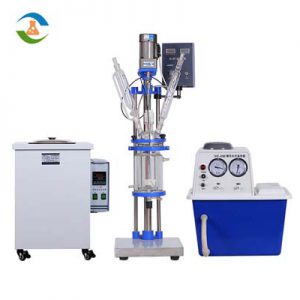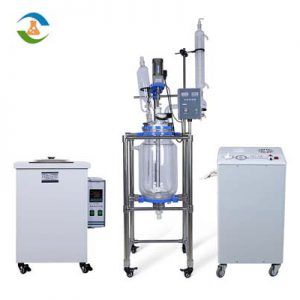S-3L double jacketed glass reaction kettle is a laboratory equipment used for chemical reactions and processes. Through the interlayer, a constant temperature (high or low temperature) hot solution or cooling liquid is injected to keep the temperature of the material in the reaction kettle constant. Heating or cooling, and stirring can be provided. double jacketed glass reactors are specially designed to handle reactions that require temperature control, providing high precision and control over reaction conditions. double jacketed glass reactors are commonly used in the pharmaceutical, chemical and biotechnology industries.

Supporting equipment for double jacketed glass reactor:
1. DLSB-5/10℃ low temperature coolant circulation pump.
DLSB-5/10°C Low Temperature Coolant Circulating Pump The low temperature coolant circulating pump is a common experimental instrument in the laboratory, which helps provide cooling for various equipment and has many uses. DLSB-5/10℃ Low Temperature Coolant Circulation Pump is used to circulate coolant, such as water or refrigerant, through the cooling system in order to transfer heat from one location to another. The main function of the low-temperature coolant circulation pump is to keep the flow of coolant in the system constant and to ensure that the temperature of the coolant is kept within the specified range.
2. SHZ-D (III) circulating water vacuum pump.
SHZ-D (III) circulating water vacuum pump is a vacuum pump that uses circulating water to generate vacuum. It operates by pumping water through a closed loop connected to a vacuum chamber. The water circulates through a heat exchanger, which removes the heat generated during pumping, and then circulates back into the pump.
Circulating water vacuum pumps are commonly used in a variety of applications including laboratory research, industrial processes and vacuum drying. They are distinguished by high pumping speeds, low running noise and low maintenance requirements. Also, they are relatively energy efficient, as the circulating water helps to remove heat from the pump and prevent overheating.
3. GYY-5L high temperature circulating oil bath.
High temperature circulating oil bath is a laboratory instrument used to keep chemical reactions and experiments at a constant temperature. It consists of a heating element and a container filled with oil that is circulated to maintain an even temperature. These baths are capable of high temperatures and are used in a variety of fields, including chemistry, biology and materials science.

Double jacketed glass reactor features:
Double jacketed glass reactors offer several advantages that make them a popular choice for laboratory chemistry:
- Temperature control: The double-jacket design allows for precise temperature control, enabling the reaction to proceed at the desired temperature, which is critical to the success of many chemical reactions.
- Ease of use: Compared with other types of reactors, glass reactors are relatively easy to use, and laboratory personnel only need minimal training to operate them.
- Transparency: The glass reactor is made of transparent glass, which can monitor the reaction intuitively. This is useful for monitoring reaction progress and identifying potential problems.
- Compatibility with corrosive chemicals: Glass reactors can be used for a variety of chemicals, including corrosive chemicals, because of their resistance to chemical attack.
- Good thermal stability: Glass has good thermal stability, which can quickly heat or cool the reactor without damaging the material.
- Easy to clean: Glass reactors are easy to clean because they can be disassembled and washed easily.
- High-pressure capability: Some double jacketedglass reactors are designed for high-pressure operation and can perform reactions under high-pressure conditions.
- Scalability: Glass reactors are available in various sizes, from small bench-top units to large industrial-scale reactors, allowing reactions to be scaled up from the laboratory to the industrial level.
The double jacketed glass reactor combines temperature control, ease of use, compatibility with a wide range of chemicals, and good thermal stability, making it a versatile and useful tool for a wide variety of chemical reactions.

Double jacketed glass reactor application:
A double jacketed glass reactor is a commonly used piece of laboratory equipment for chemical reactions and can be used for a wide range of experiments and applications, including:
- 1. Compound synthesis: The double-layer jacket design can control the temperature, which is suitable for synthesizing compounds under controlled conditions.
- 2. Polymerization reaction: The double jacketedglass reactor can be used for polymerization reactions that require heating and cooling, such as the synthesis of polymers and copolymers.
- 3. Distillation separation: through temperature control in the jacket, the reactor can also be used for distillation separation of the mixture.
- 4. Batch reaction: The double jacketedglass reactor can be used for batch reaction, the reaction operation is completed, and then the product is collected.
- 5. Continuous flow reaction: The double jacketedglass reactor can also be used for continuous flow reaction, the reactants are continuously fed into the reactor, and the products are continuously collected.
- 6. Solvothermal reaction: Solvothermal reaction is a chemical reaction that occurs in a solvent under high temperature and pressure, and can also be carried out in a double jacketedglass reactor.
- 7. Photochemical reactions: double jacketedglass reactors can be used for photochemical reactions, where light is used to initiate or drive chemical reactions.
double jacketed glass reactors are used in a wide variety of applications, including chemical synthesis, polymerization, distillation, and other reactions that require precise control of temperature, pressure, and mixing. double jacketed glass reactors are ideal for the production of pharmaceuticals, chemicals, and other high-value products that require tightly controlled reaction conditions.

Double jacketed glass reactor operation method:
- Preparation: Prepare the reactor by thoroughly cleaning the reactor and installing the required equipment such as agitator and temperature control system.
- Loading: Reactants and reagents are loaded into the reactor through the central opening of the lid.
- Heating/cooling: A heating/cooling jacket is used to control the temperature of the reaction mixture.
- Agitation: The agitator is used to mix the reaction mixture and ensure that all reactants are in contact with each other.
- Monitoring: Monitor reaction conditions throughout the reaction, including temperature, pressure, and mixing.
- Completion: Once the reaction is complete, cool the reactor and remove the product.
In conclusion, the double jacketed glass reactor is a versatile and sophisticated laboratory equipment that can be used for various chemical reactions. Its precise temperature and pressure control, as well as its ability to mix reaction mixtures, make it ideal for producing high-value products.
Parameter
Single layer glass reactor
| Model | Stirring Power(W) | Stirring Speed(rmp) | Heating Power(kW) | Capacity(L) | Temperature Using Range(℃) | Motor Torque(g/cm) |
| F-1L | 60 | 0~1000 | 0.5 | 1 | RT-250/RT-350 | 2000 |
| F-2L | 60 | 0~1000 | 0.8 | 2 | RT-250/RT-350 | 2400 |
| F-3L | 60 | 0~1000 | 1.2 | 3 | RT-250/RT-350 | 2400 |
| F-5L | 60 | 0~1000 | 1.5 | 5 | RT-250/RT-350 | 4800 |
| F-10L | 120 | 60~600 | 3 | 10 | RT-250/RT-350 | 1000 |
| F-20L | 120 | 60~600 | 4.5 | 20 | RT-250/RT-350 | 1200 |
| F-30L | 120 | 60~600 | 6 | 30 | RT-250/RT-350 | 1200 |
| F-50L | 120 | 60~600 | 7 | 50 | RT-250/RT-350 | 1500 |
| F-100L | 180 | 60~600 | 9 | 100 | RT-250/RT-350 | 3000 |
Jacketed glass reactor
| Model | Power(W ) | Stirring Speed(rmp) | Diameter | Capacity(L) | Power Supply | Motor Torque(g/cm) |
| S-1L | 60 | 0~600(Max.1300) | 12 | 1 | 220V 50/60 Hz | 2000 |
| S-2L | 60 | 0~600(Max.1300) | 12 | 2 | 220V 50/60 Hz | 2400 |
| S-3L | 60 | 0~600(Max.1300) | 12 | 3 | 220V 50/60 Hz | 2400 |
| S-5L | 60 | 0~600(Max.1300) | 12 | 5 | 220V 50/60 Hz | 4800 |
| S-10L | 120 | 0~600(Max.1300) | 12 | 10 | 220V 50/60 Hz | 1000 |
| S-20L | 120 | 0~600(Max.1300) | 12 | 20 | 220V 50/60 Hz | 1200 |
| S-30L | 120 | 0~600(Max.1300) | 12 | 30 | 220V 50/60 Hz | 1200 |
| S-50L | 120 | 0~600(Max.1300) | 12 | 50 | 220V 50/60 Hz | 1500 |
| S-100L | 250 | 0~600(Max.1300) | 15 | 100 | 220V 50/60 Hz | 3000 |
FAQ:
1. How to control the temperature of the double jacketed glass reactor?
The temperature in a double jacketed glass reactor is usually controlled by circulating a temperature-controlling fluid, such as water or oil, through the jacket. A heating or cooling system is used to regulate the temperature of the fluid, which in turn regulates the temperature of the reactor contents.
2. What is the maximum pressure that the double jacketed glass reactor can withstand?
The maximum pressure that a double jacketed glass reactor can handle depends on the materials of construction, design and size of the reactor. Some reactors are designed to handle positive or negative pressures, while others may have lower maximum pressure ratings.
3. What is the type of agitator used in the double jacketed glass reactor?
The type of agitator used in a double jacketed glass reactor can vary by manufacturer and model. Some common types of stirrers include magnetic stirrers, overhead stirrers, and propeller stirrers.





